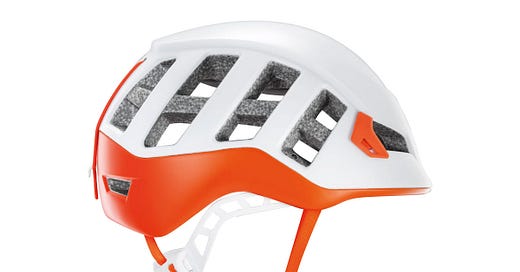The following Oh Shit Award is another simple one, namely that you should never skip protection just because the terrain is easy, 3rd class, or ‘scrambling’. Many is the time when I’ve soloed up easy ground, heading for the meat of the pitch, only to find there’s no gear once you’re at said meat, which means you’re free soloing unless you find a bit of humility and down climb and place some gear. But sometimes, climbing back down is not an option…
Last summer I almost killed myself falling off a trad route without putting any protection in. My helmet probably saved my life and certainly prevented serious neurological injury.
We spent a day in June on a seaside cliff climbing easy trad-routes. Being new to trad-climbing we climbed well within our limits, but the climbing was fun and we had a good flow.
To finish off the day we were doing a 5+ Norwegian grade route. It started with easy scrambling leading up to a crack in a corner. Without looking behind, or placing protection, I climbed the scrambling section to the crack in the corner and immediately continued up the corner to a promising first cam-placement - about 2 meters above the scrambling section. Unfortunately, the crack was flaring and I couldn't find any acceptable placements for any gear. I looked down and realized that I now in effect was 5 to 6 meters of the ground, with no gear in place.
Oh shit.
I had a good stance, but fear gripped me and I decided to downclimb towards the last shelf of the scrambling section. The shelf was about 30 cm deep and not easy to jump down to. With the first tenous shift of my weight, my left foot came off the rock and I tumbled down without any control.
My thoughts were surprisingly cool and clear - Is this the way I'm gonna go? Hitting the rock with my head - Wow, that was a hard hit! And so on, until the whiteout of complete pain and loss of breath upon hitting the ground beneath my fiancee’s feet.
Luckily I survived, but walking out through the talus we came in through was not an option. We waited for three hours on the cliff in the sun and wind of early summer with an ambient temperature of about 20 degrees Celcius. I was lucky to have good company and down jackets, because it was freezing and quite agonising to wait for the helicopter.
I ended up with a couple of fractured cervical vertebrae, a lot of fractured ribs and a broken hand. Through luck, and thanks to my helmet, I had no neurological injuries and I got to learn quite a few things that day.
Maybe you have some followers who are beginners that find this helpful if you feel you can use it. Let me know if you have any questions
Regards
Jonatan
I remember several occasions when I climbed with climbers who were much better than me, one of them a gold plated climbing legend, but noticing how they still placed gear even when there on easy ground, where I thought there was no way they were going to fall off.
I also remember being told by one of these climbers, that when you’re leading, it’s down to your own judgement when to place protection, when and where you want, and not to let yourself, second guess yourself, thinking about what others would want to to do. Basically, you’re on the sharp end, place all the gear you want.
Said climbers were good, and so placing a nut here, or a cam, would only take a few seconds, and then they’d be off again, and some would even place several pieces before they reach the real climbing, creating a solid nest of pro to put their minds at rest.
When they climbed they would maintain a steady pace and speed, and would just plug in gear every few body lengths - or when good gear appeared - no matter how easy or hard the climbing was.
The longer you climb, the more you’ll understand that broken holds tend to happen more often on the easy ground than hard, as well as puddles and damp spots, lichen, muck, grass and general “trip and slip” hazards. Such terrain is also less than vertical, and so any falls are far more dangerous and injurious (compared to vertical rock), so any Black Swan fall is going to be more serious, so it’s worth investing a little time into Black Swan insurance.
I suppose this leads to the question, why not place gear on the easy ground? I suppose there are a number of reasons, like wanting to get to the ‘proper’ climbing as fast as you can, to speed up the pitch (an easy trap on multi-pitch routes), or maybe even forego gear altogether, that you’re so solid and hardcore you don’t need gear like other mortals (this is, of course, a short term win with long term consequences).
In terms of both ‘getting to the climbing’ and speed, nothing slows up a pitch more than a leader who is too scared to commit to a move, and so fannys around for twenty minutes before committing to a life and death - roll of the dice - suicide sequence. And of course, falling off is going to slow the climb, and maybe life itself, to a hard stop.
As for ego, the ego is one thing you have to hammer as early as you can in your climbing career and to be mature enough to separate that out from physical and emotional confidence, to view placing gear when you don’t need it as not a sign of weakness or timidity, but a sign of rock mastery (and humility).
Oh, and helmets are cool!




